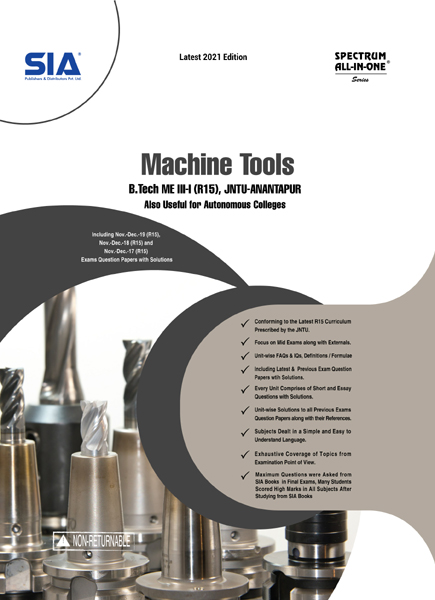

Note: Please check your Spam or Junk folder, in case you didn't receive the email with verification code.
SYLLABUS
UNIT-I
Elementary treatment of metal cutting theory – Elements of cutting process – Geometry of single point tool and angles, Chip formation and types of chips – Built up edge and its effects, Chip breakers. Mechanics of orthogonal cutting – Merchant’s force diagram, Cutting forces – Cutting speeds, Feed, Depth of cut, Heat generation, Tool life, Coolants, Machinability – Economics of machining. Cutting tool materials and cutting fluids – Types and characteristics.
UNIT-II
Engine lathe – Principle of working – Specification of lathe – Types of lathes – Work holders and tool holders – Taper turning, Thread turning and attachments for lathes. Turret and capstan lathes – Collect chucks – Other work holders – Tool holding devices – Box and tool layout. Principal features of automatic lathes – Classification – Single spindle and multi-spindle automatic lathes – Tool layout and cam design.
UNIT-III
Drilling and Boring machines – Principles of working, Specifications, Types, Operations performed – Tool holding devices – Twist drill – Boring tools – Machining time calculation. Shaping, Slotting and Planning machines – Principles of working – Principle parts – Specifications, Classification, Operations performed. Machining time calculations.
UNIT-IV
Milling machine – Principles of working – Specifications – Classification of milling machines – Principal features – Machining operations, Types and geometry of milling cutters – Methods of indexing – Accessories to milling machines. Grinding machine – Theory of grinding – Classification – Cylindrical and surface grinding machine – Tool and cutter grinding machine – Special types of grinding machines – Grinding wheel; Different types of abrasives – Bonds specification and selection of a grinding wheel. Static and dynamic balancing of a wheel. Truing and dressing of wheels. Lapping, Honing and Broaching machines – Comparison of Grinding, Lapping and Honing, Machining time calculations.
UNIT-V
Principles of design of jigs and fixtures and uses, 3-2-1 classification of jigs and fixtures – Principles of location and clamping – Types of clamping and work holding devices – Typical examples of jigs and fixtures. Unit built machine tools – Multi-spindle heads. Power units – Principal of working types of UBMTS characterization, applications.
 No Preview is available for this book
No Preview is available for this book

 Get 100 instant uPoints on the purchase of Rs.100 or above for each order.
Get 100 instant uPoints on the purchase of Rs.100 or above for each order.
CategoriesEngineering

Format EPUB

TypeeBook